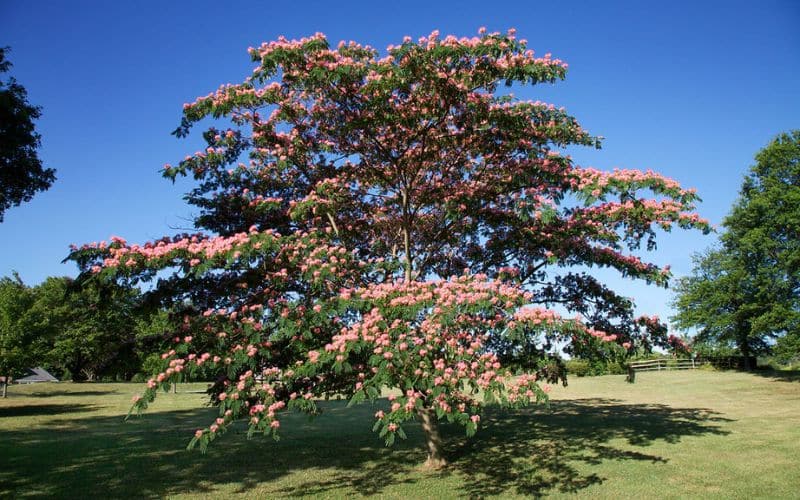
The Mimosa Silk Tree (Albizia Julibrissin)
The Mimosa Silk Tree, scientifically known as Albizia julibrissin, is a captivating ornamental tree that has captured the hearts of gardeners around the world. With its delicate, feathery leaves and vibrant pink mimosa flowers, it’s a sight to behold when in full bloom.
What Makes the Mimosa Tree So Unique?
The mimosa tree is not just another pretty face in the garden. Its unique silk-like flowers and the ability to grow up to 20 feet make it a standout feature. Have you ever seen a chocolate mimosa? This special variant adds a touch of exotic elegance to any landscape.

Is the Mimosa Tree Invasive in Ontario?
While the mimosa tree is admired for its beauty, it’s essential to know that in some regions, it can be considered an invasive species. In Ontario, the tree’s invasive nature is limited, but it’s wise to consult with a local gardener or expert to ensure it’s suitable for your area.
Growing Mimosa: A Step-by-Step Guide
Growing a mimosa tree is a rewarding experience. Here’s a step-by-step guide to help you sprout and nurture your mimosa seedling:
- Planting Mimosa Seeds: Start with quality mimosa seeds. Plant them in well-drained soil and water regularly until they sprout.
- Choosing the Right Spot: Mimosa trees thrive in hardiness zones 6-9. Check the USDA guidelines to ensure your location is suitable.
- Fertilizing: A balanced fertilizer helps the tree growing process, promoting healthy growth and vibrant blooms.
- Watering and Care: Mimosas are hardy trees but require regular watering, especially during dry periods.
How to Prune a Mimosa Silk Tree for Optimal Growth?
Pruning your mimosa tree is essential for its health and appearance. Remove dead or wilted branches and shape the tree to your liking. Pruning encourages the tree to bloom more profusely.
Caring for Albizia Julibrissin: Tips and Tricks
Caring for your mimosa tree ensures it remains a healthy and attractive feature in your garden. Here are some tips:
- Watering: Mimosa trees like moist soil but not standing water.
- Sunlight: They love full sun and will bloom best in a sunny spot.
- Soil: Well-drained soil enriched with organic matter is ideal.
What Are the Common Pests and Diseases of the Mimosa Tree?
Like any plant, the mimosa tree can be affected by pests and diseases. Watch for signs of wilt or discoloration and consult a local expert if you notice anything unusual.

Is the Mimosa Tree Suitable for Your Garden?
The mimosa tree’s ornamental beauty is undeniable, but is it right for your garden? Consider its size, hardiness, and potential as an invasive species in your region.
The Cultural Significance of the Mimosa in Various Cultures
The mimosa tree is more than just a beautiful flower tree. In various cultures, it symbolizes love, sensitivity, and celebration. Its silk-like flowers are often used in ceremonies and rituals.
Chocolate Mimosa: A Special Variant Worth Exploring
The chocolate mimosa, with its unique dark foliage, is a rare and beautiful variant of the mimosa tree. If you’re looking to add something extraordinary to your garden, this might be the perfect choice.
Conclusion: Embracing the Beauty of the Mimosa Silk Tree
The mimosa silk tree is a delightful addition to any garden. From its sprouting seedling stage to its full 20-feet glory, it’s a joy to watch it grow and bloom. Whether you’re a seasoned gardener or just starting, the mimosa tree offers endless possibilities for enjoyment and exploration.








